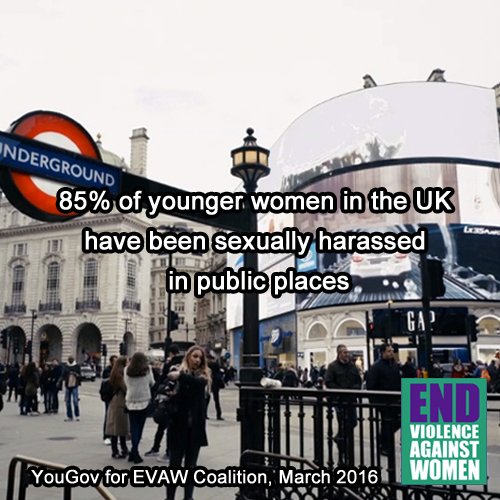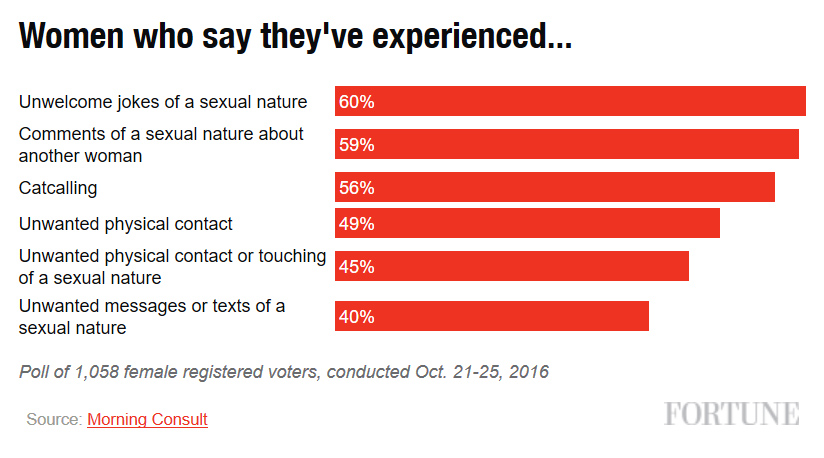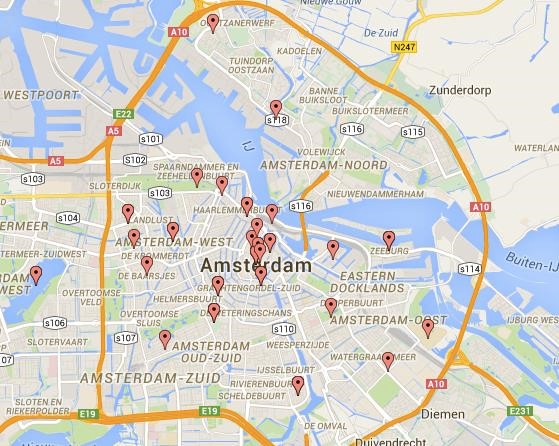A new phone poll of more than 1,000 randomly selected registered female voters in the USA finds that sexual abuse is common. Among the findings, 56% had experienced “catcalling” and 45% had experienced unwanted sexual touching.
New Studies in the Philippines and Israel
The UK was not the only country to have a new study about street harassment released for International Women’s Day, statistics were released in the Philippines and Israel, too.
Philippines:
In February 2016, SWS surveyed people in barangays Payatas and Bagong Silangan in Quezon City regarding sexual harassment in public spaces.
Prevalence:
88% of women ages 18 to 24 experienced sexual harassment at least once.
1 in 7 of the surveyed women experienced sexual harassment at least once every week in the past year.
Types:
Across all ages, 12 to 55 and above, wolf whistling and catcalling were the most common forms. However, 34% of women experienced the “worst forms” of sexual harassment: flashing, public masturbation, and groping.
Perpetrators:
Seventy percent of women said they were harassed by a “complete stranger,” while others said it was by “someone they see around the neighborhood,” acquaintances, and “someone they are close to.”
3 out of 5 men surveyed confessed to committing a form of sexual harassment at least once in their lifetime, while 1 in 7 admitted to doing it at least daily over the past year.
When:
The majority of the incidents happen in broad daylight. Seventy percent of cases happen during the day, between 6 am and 6 pm, and only 4% of cases were reported occurring at night.
You can read more survey results and learn about the UN Women campaign underway in the city via this Rappler article.
Israel:
The organization NA’AMAT release a survey about youth and sexual harassment, the following is pulled from a Jerusalem Post article about it.
Prevalence:
68% of girls responded that they were harassed by a man they didn’t know on the street at least once, while 45% said this happened more than once.
Perpetrators:
47% of boys admitted that they had shouted out to a woman or girl that they didn’t know on the street and around 34% said they had done this more than once.
Attitudes:
“A little over a third of youth – both boys and girls – said that if a woman acts or dresses provocatively then she shares in the blame of sexual assault. Only 53% of youth felt that only the attacker was to blame in the case of sexual assault.”
The UK’s First National Street Harassment Study
 End Violence Against Women Coalition, our allies in the UK, commissioned YouGov to conduct the first national poll on street harassment. The results were released today, for International Women’s Day.
End Violence Against Women Coalition, our allies in the UK, commissioned YouGov to conduct the first national poll on street harassment. The results were released today, for International Women’s Day.
Prevalence:
64% of women of all ages have experienced unwanted sexual harassment in public places. (This is almost the same as the USA, our 2014 study found that 65% of women had been harassed.) Additionally, 35% of women had experienced unwanted sexual touching.
Age:
When they looked at just young women ages 18-24, however, the percentages increased significantly: 85% had faced sexual harassment in public spaces and 45% had experienced unwanted sexual touching.
Related, across all ages of women, most said it began at a young age. More than 1 in 4 said it happened before age 16, and more than 3 in 4 said it happened by age 21.
Bystanders/Upstanders:
Sadly, only 11% of women said anyone had intervened when they were harassed though 81% said they wished someone had.
Changing Their Life:
When it comes to feeling safe, 63% of women (versus 45% of men) said they generally feel unsafe in public spaces and almost half do conscious “safety planning” when they go out in the evenings.
What Can We Do:
When asked what should be done, many said “they supported more police (53%), better street lighting (38%), more transport staff (38%) and public awareness campaigns encouraging others to intervene (35%). No women we asked believed this problem should be ignored and no measures taken.”
Racialized Sexual Harassment:
Because women of color may also face racialized sexual harassment, EVAW partnered with Imkaan to produce a five minute film featuring young women of color talking about their experiences.
In discussing what it feels like to experience racist sexual harassment one woman in the film says:
“My experiences are different as a Black woman than they are for my white friends. I should be ‘up for it’ or I am ‘fair game’, or I shouldn’t care if my body is touched in a specific way.
And another woman says:
“After me ignoring them, that’s when it turns racial, so that’s when it might be ‘you black this’ or ‘you black that…how dare you ignore me’.”
In a press release for the film and survey, Lia Latchford, Policy and Campaigns Coordinator at Imkaan said:
“Our film tells a powerful story of young black women’s everyday experience of racialised sexual harassment. For us, we cannot ‘leave race out of it’ because the way we are treated is based on how our whole identities are perceived as black women. This harassment and abuse often uses racist stereotypes and insults as an attempt to put black women in our place. Everyone, adults and young people alike, need to talk about it and it needs to stop.”
Sarah Green, Acting Director at the End Violence Against Women Coalition said:
“Sexual harassment is an everyday experience which women and girls learn to deal with, but it’s time to hold a mirror up to it and challenge it. We did this survey to find out about the scale of sexual harassment and the impact it has on the way women live. If women are planning their lives around not being harassed or assaulted, they are not free. Women should be free to live their lives without the threat of harassment and violence, not having to plan and limit their choices to make sure they’re safe.”
The Netherlands: Demystifying Dutch Tolerance
Eve Aronson, Amsterdam, the Netherlands, SSH Blog Correspondent
Have you heard of the Dutch Myth of Tolerance? It’s not a myth in the mythical sense, and it’s not a fairytale, though it does sound admittedly magical.
Since the 17th century, the Netherlands has been a smorgasbord of races, ethnicities and religions and has continuously championed itself on what are known as “pillars” of tolerance.
The Dutch Myth of Tolerance is reflective of the disintegration of these pillars towards what has become an increasingly harsh critique of the narrative of ‘acceptance and multiculturalism’ in the Netherlands (or the lack thereof).
At first, the presence of this myth throughout my research was subtle. People told me about their experiences of street harassment and may have thrown in some (racially) identifying characteristics of their harassers. But after several months, it became evident that a more solid smokescreen lurked, and that the notion of Dutch pluralism and tolerance was not always as strong as it presented itself to be.
When people talk about street harassment in Amsterdam, it is not uncommon to highlight the race or ethnicity of one’s harassers, particularly if they are of Moroccan or Turkish decent, two of the largest minority populations in the Netherlands. Often times, the harasser is also tied to a particular neighborhood. For example, one person I talked to said: “In my experience, harassment was worse in neighborhoods with a lot of immigrants from cultures…Moroccans for example.” Another echoed: “A lot of catcalling, primarily from members of black communities”.
A report released in March of this year by the city of Amsterdam also highlighted particular minority-populated neighborhoods and communities as being more affected by street harassment, which arguably worked to further emphasize the link between street harassment and race or ethnicity.
Many of you might also recall the October 2014 video of a woman walking through the streets of New York in the US. The video heavily criticized for selectively showing a disproportionate number of men of color harassing the (white) woman in the video. Emphasizing connections between street harassment, race and location is not only completely inaccurate; it also strips accountability from a significant proportion of harassers who fall outside of these stereotypes and who are harassing women in Amsterdam just as often.
Below is a map of locations tagged by 48 respondents of a recent street harassment survey that I conducted in Amsterdam. Take a good look at where the majority of incidents are reported:
The majority of the geotagged incidents were reported in the center of the city, mostly around touristy areas and not in areas of the city known to have large minority populations (Biljmer, Zuid-Oost and Oost, for example). What this data does then, is encourage a revisiting of stereotypes of street harassment in Amsterdam, albeit from a purely geographic perspective. And this is just a start. The more stereotypes are checked—particularly using visual tools and visualizations—the more people are realizing that street harassment extends beyond race, ethnicity and geographical area.
What kind of impact does this have on the ground? Understanding street harassment as part of broader power structures does not mean that everyone gets this memo, and in this vein, individuals’ lived experiences are critical to take into account. But without denying individual experiences with street harassment, it is important to underline the implications of making generalized statements about races or communities.
Starting up a Hollaback! in Amsterdam is one way to work towards exposing exactly what happens on the ground and where. Geotagging experiences of street harassment not only confronts the Dutch Myth of Tolerance but it also provides an important starting point for conversations about street harassment and race in the Netherlands. Coupled with other awareness-raising initiatives and campaigns, addressing racial stereotyping in conversations about street harassment through such visual tools also encourages a look at street harassment through a much broader lens—one that unfortunately does not make the fight against street harassment easier but who said this was going to be easy? Ultimately, what taking a more comprehensive approach to street harassment does, is it makes the work more strategic and more effective in the long run.
You can find the full analysis of the Amsterdam survey results here or by contacting Eve at evearonson@gmail.com. Follow Eve and Hollaback! Amsterdam on Twitter at @evearonson and @iHollaback_AMS and show your support by liking Hollaback! Amsterdam’s Facebook page here.


